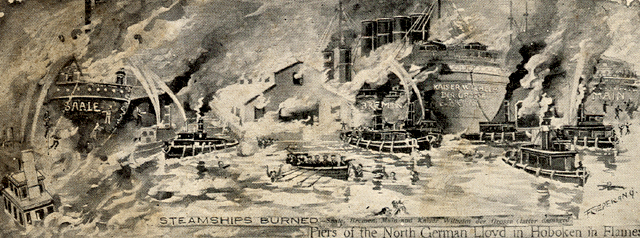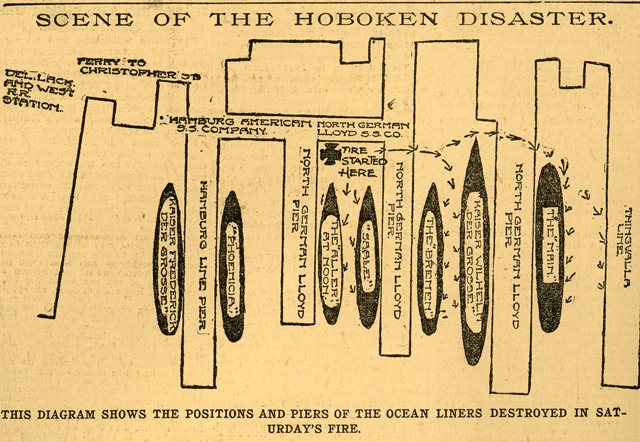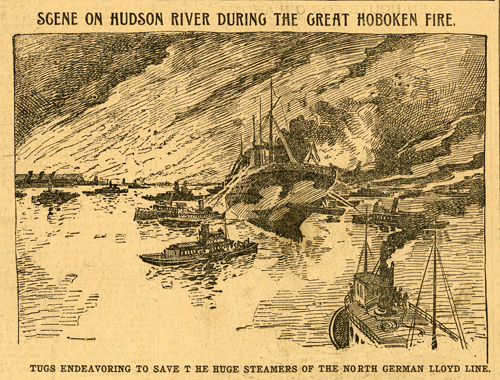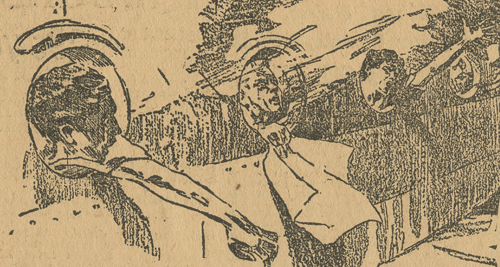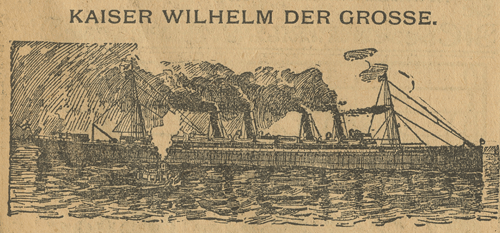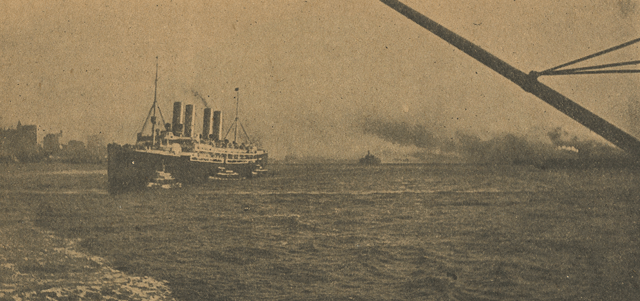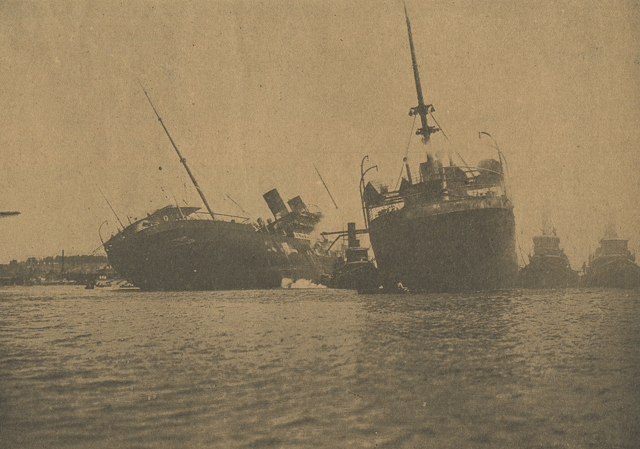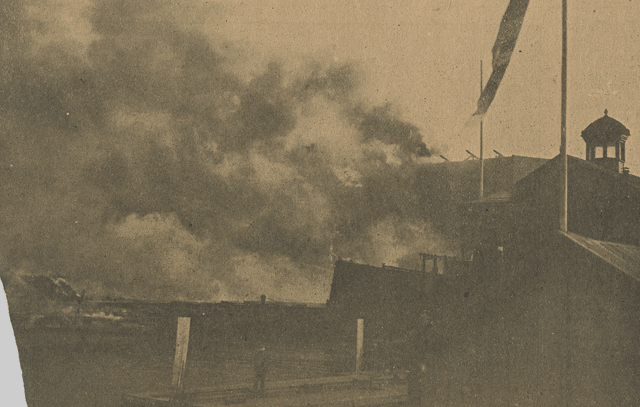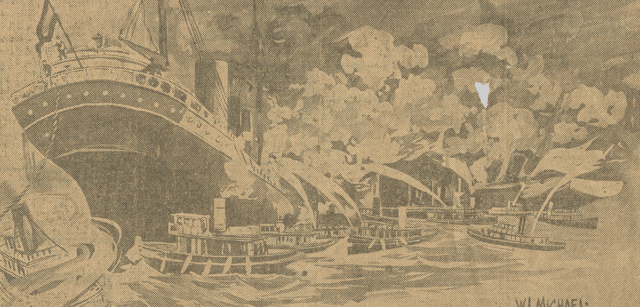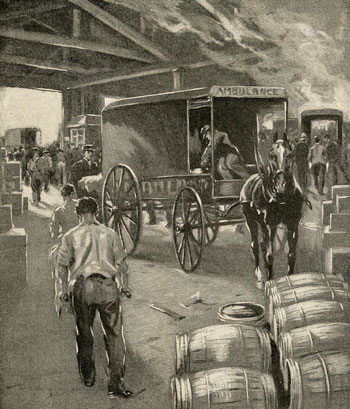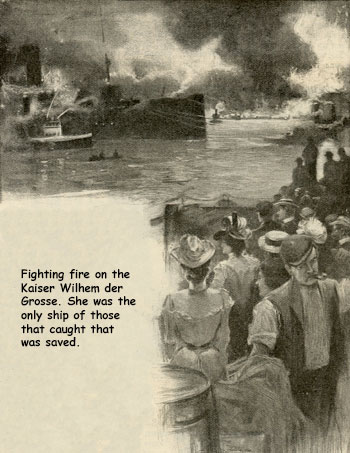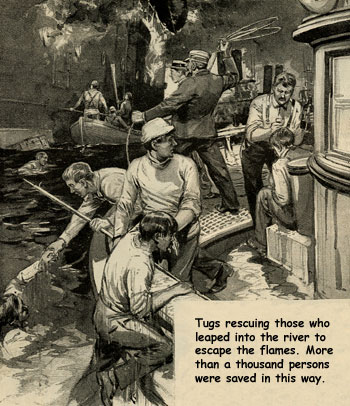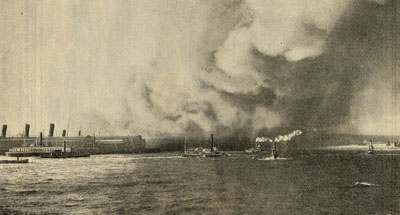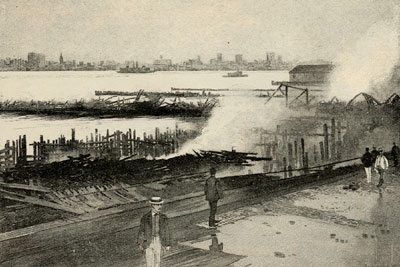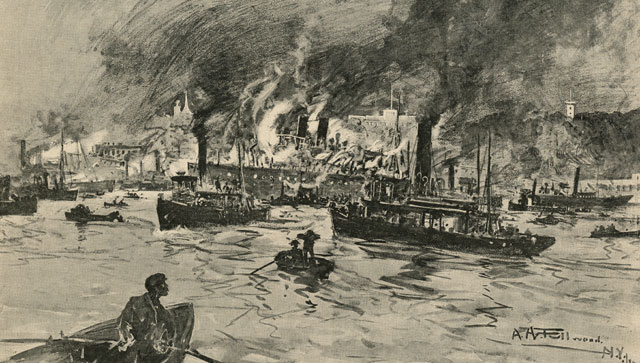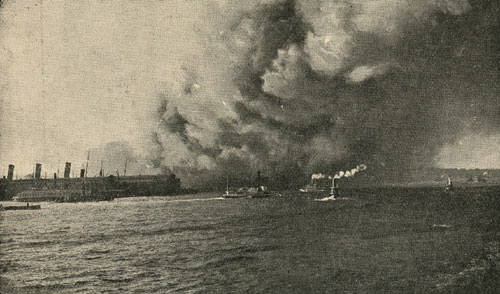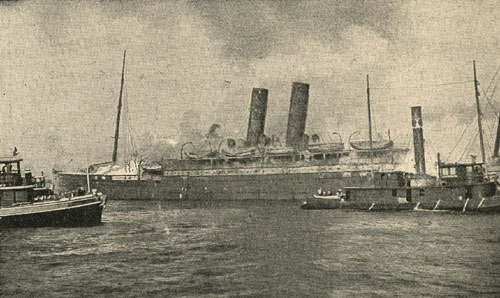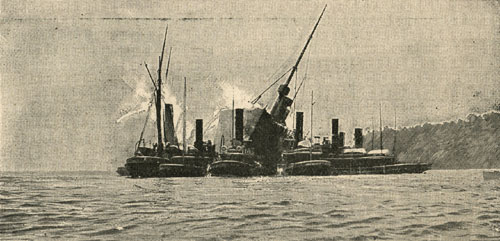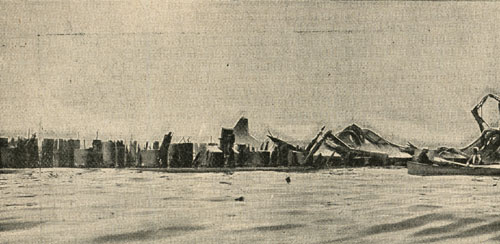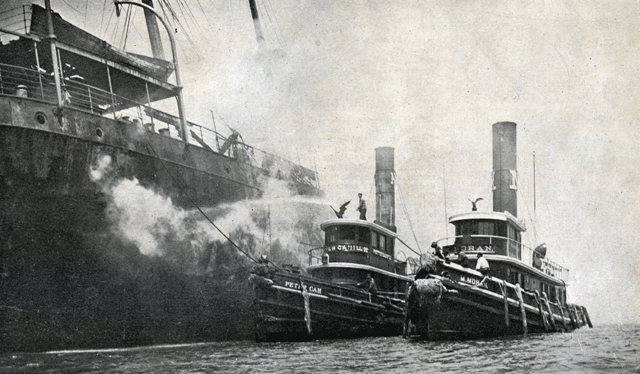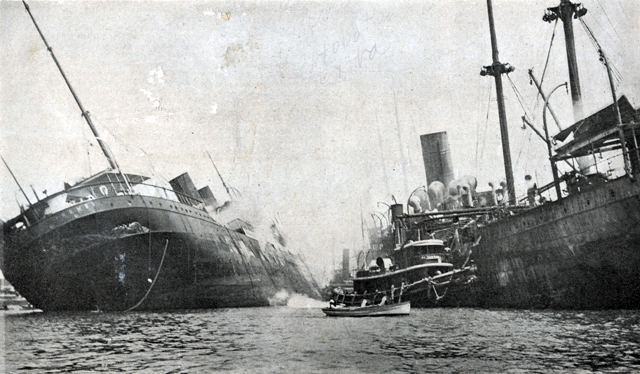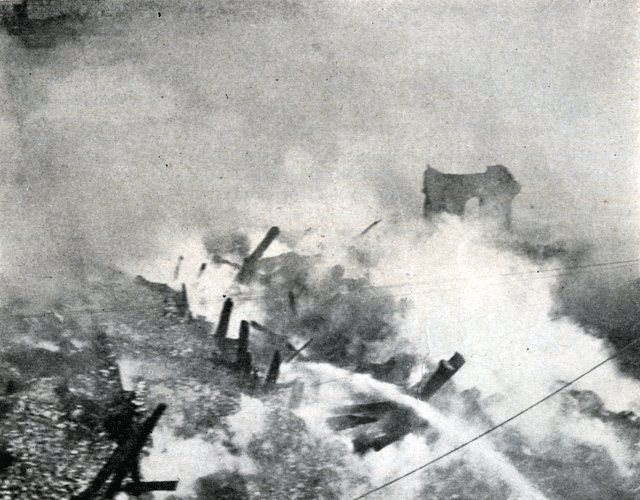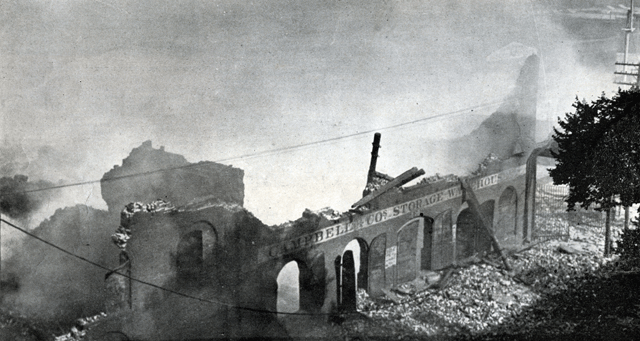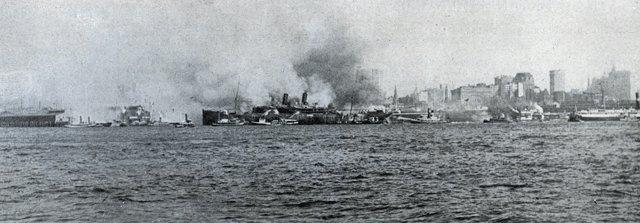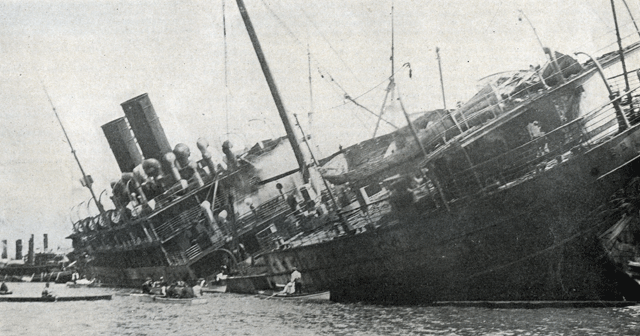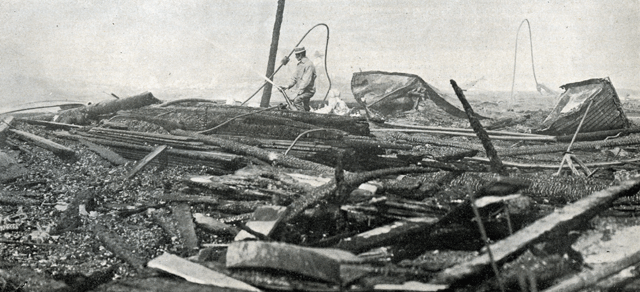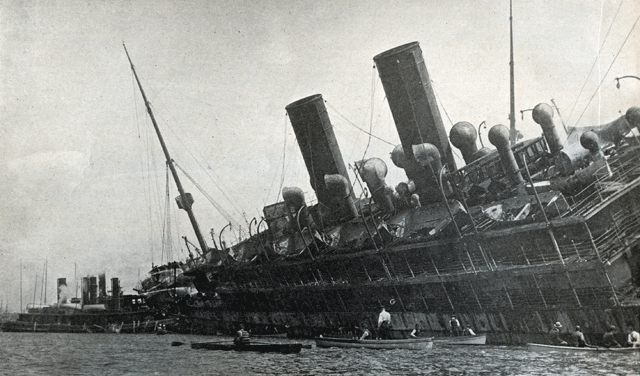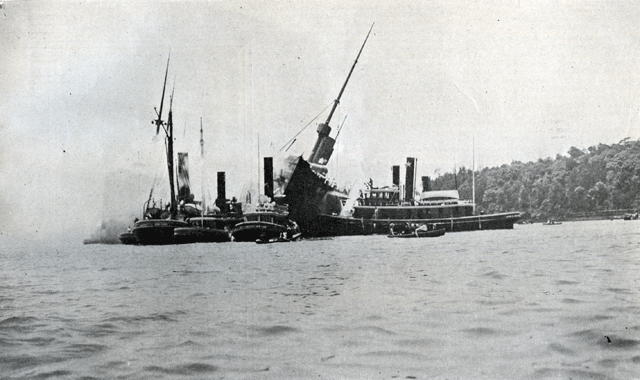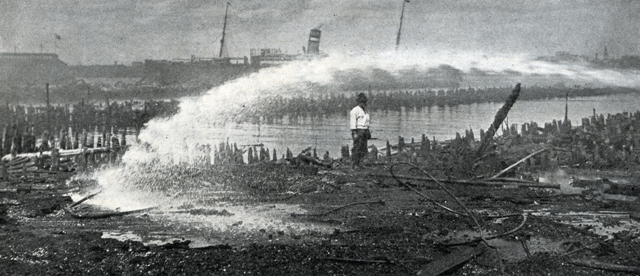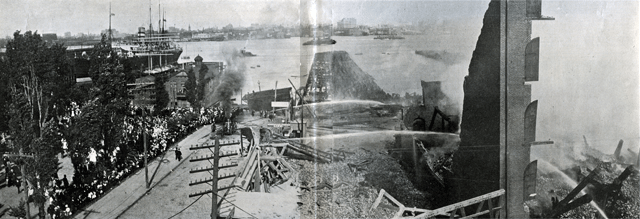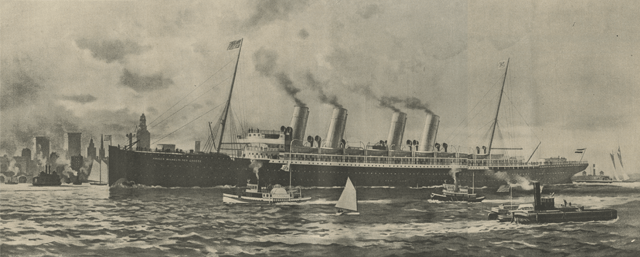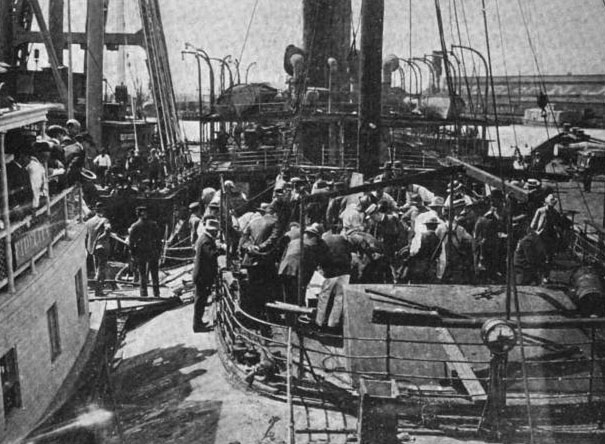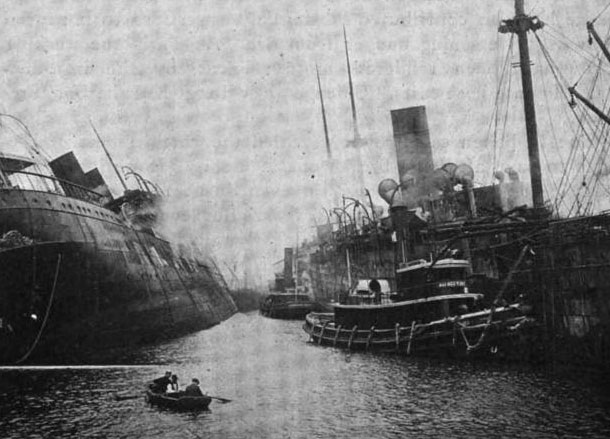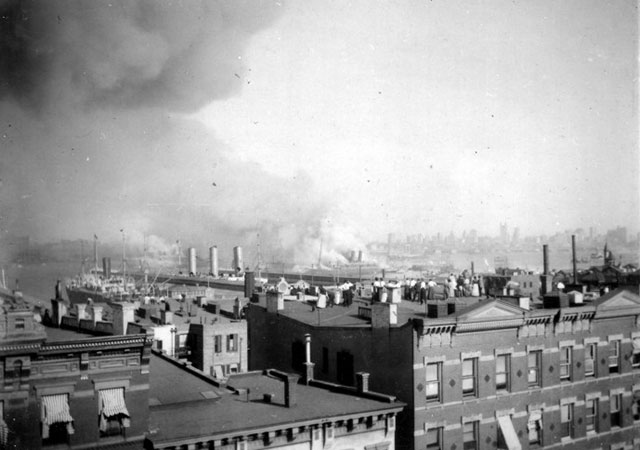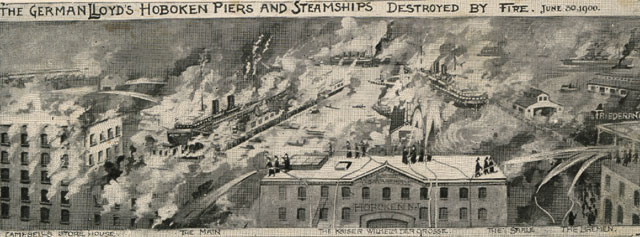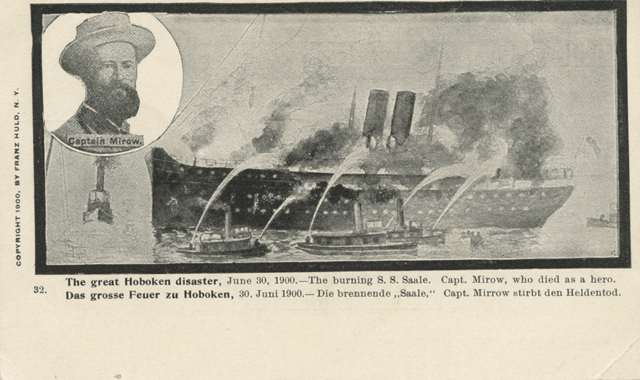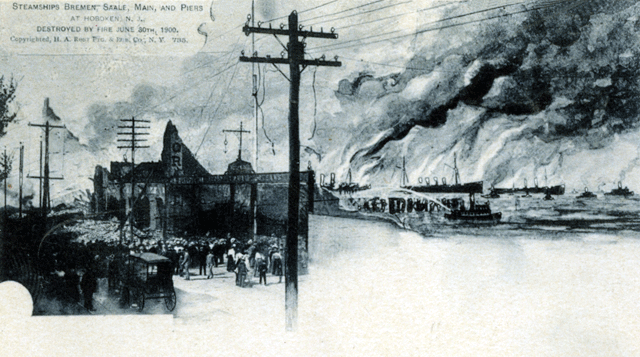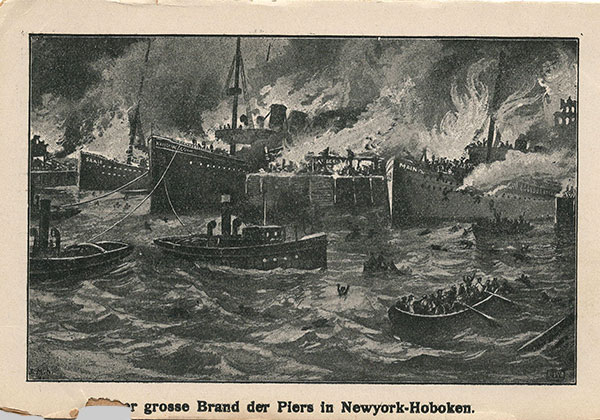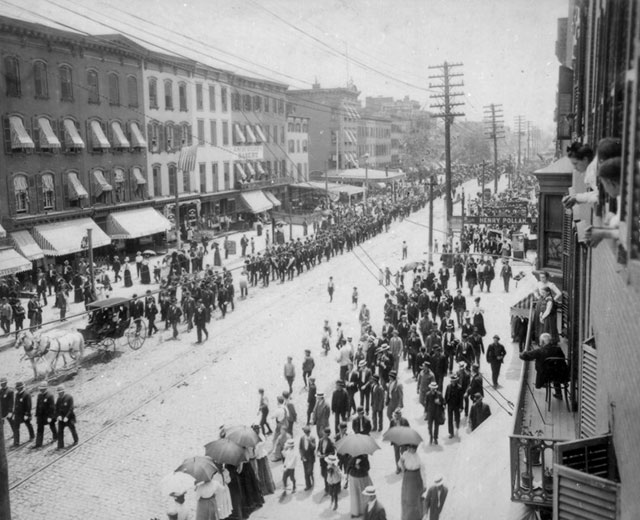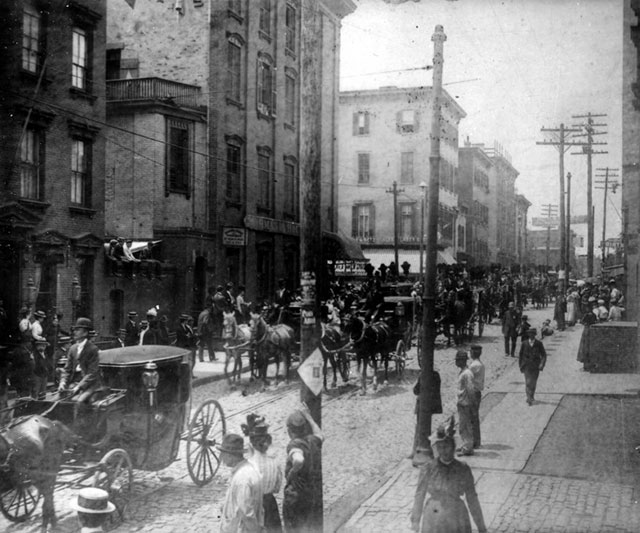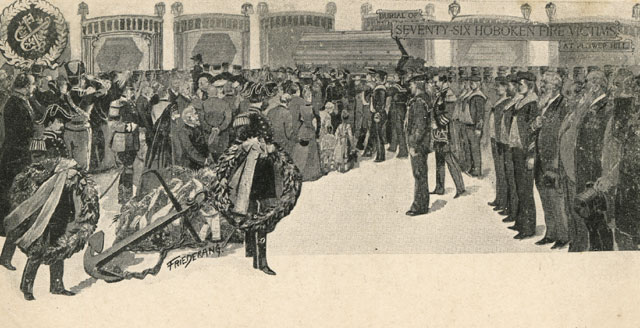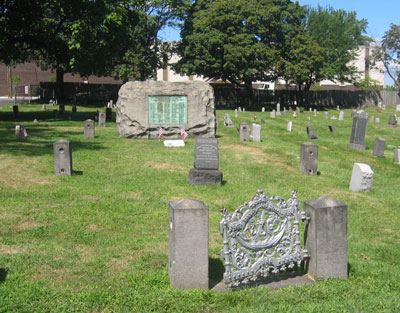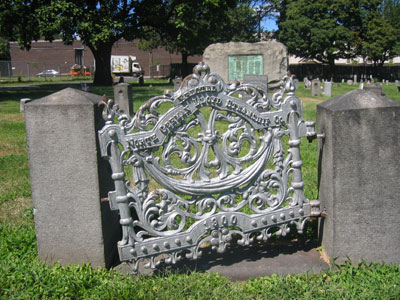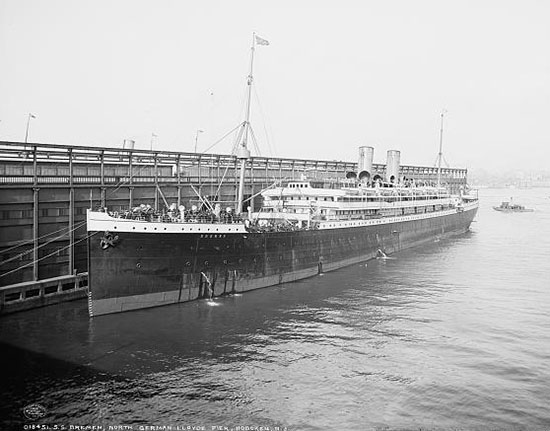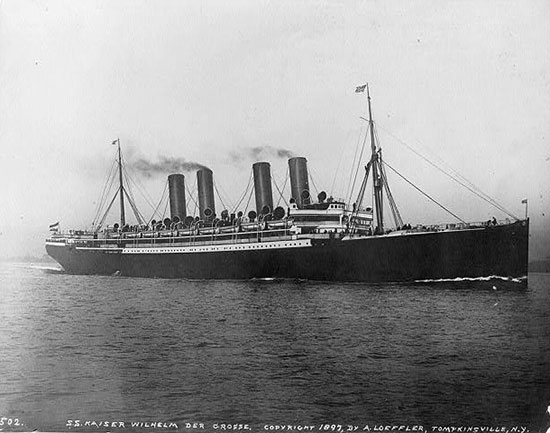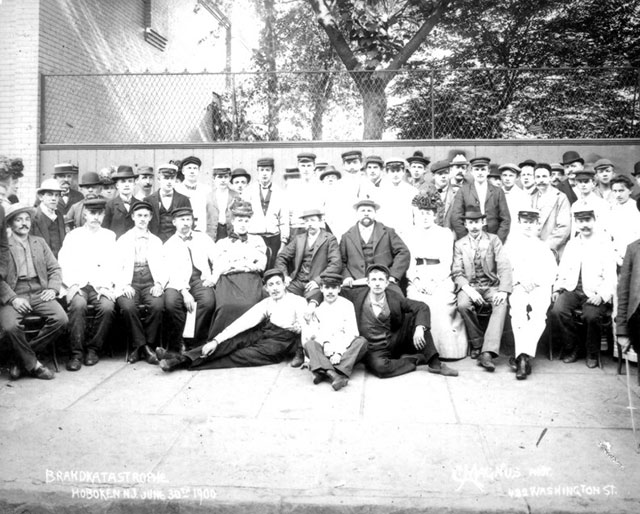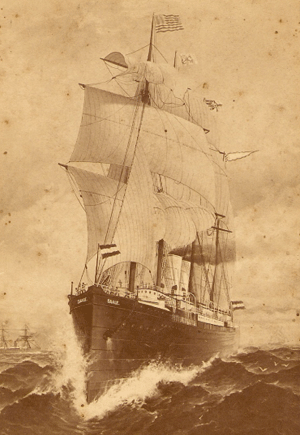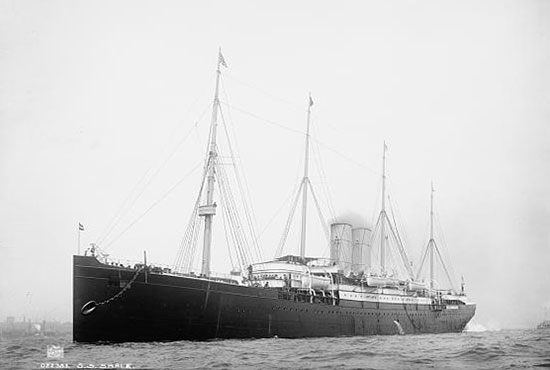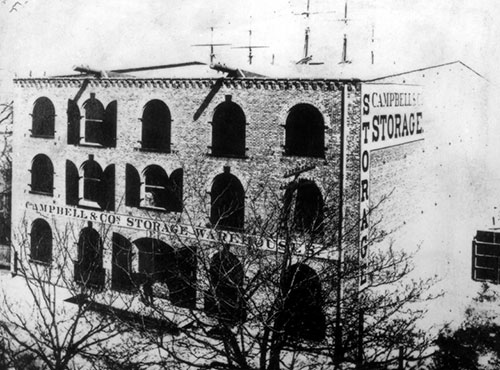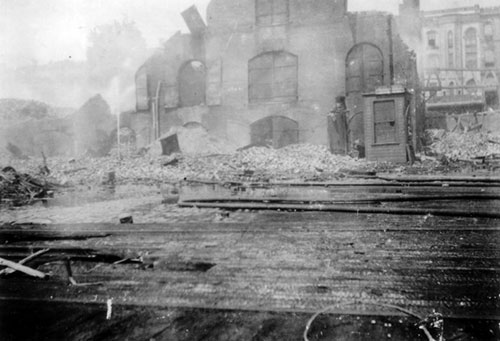In October 2010 Norman Brouwer generously shared the following story of the roll of
the tug boat, ADMIRAL DEWEY, and other tugs on that fateful day in June 1900:
(Based on U.S. District Court records held by the Manhattan Branch of
the National Archives; including court testimony of Captain George Belgarde
of the ADMIRAL DEWEY, and Chief Engineer Johann Tinken of the liner BREMEN.)
The worst disaster in the history of New York Harbor involving ocean shipping took
place on the waterfront of Hoboken, New Jersey in the summer of 1900.
At the time there were seven covered piers between the ferry terminal in
South Hoboken and Stevens Point. The two southernmost were occupied by
the Hamburg-American Line, and the two northernmost by the Scandinavian-American
Line. The three remaining piers were used by the North German Lloyd Steamship
Company, also known as "The Bremen Line." On June 30, 1900 there were four passenger liners lying at the North German Lloyd Piers. The MAIN was on the north side of the north pier and the KAISER WILHELM DER GROSSE was on its south side. The BREMEN was across the slip from the KAISER WILHELM on the north side of the middle pier, and the SAALE was on the south side. There was no ship at the southernmost pier. In addition to the liners, the slips were filled with barges and lighters carrying cargo, or coal to fuel the ships. More cargo was stacked in the pier sheds. There were no passengers on the ships, but most crew members were on duty, longshoremen were at work on the piers, and there were people visiting the ships.
June 30th was a pleasant, warm summer day with few clouds in the sky, but
there was a fairly brisk wind blowing from the southwest.
Shortly before 4:00 in the afternoon, fire was discovered in cotton stored
on the pier near the SAALE. Quickly out of control, it spread throughout the
pier, to the adjacent piers, and to the ships. By the time it had run its course,
the three North German Lloyd Piers and one Scandinavian Line pier were in ruins;
the liners SAALE, BREMEN, and MAIN were almost totally burned out, and s
omewhere between 300 and 400 people had died.
In 1900 the leading supplier of coal to fuel ocean steamships in the Port
of New York was the Berwind-White Coal Mining Company.
Early on June 30th the two tugboats the company was employing in the
Harbor, the ADMIRAL DEWEY and EDWARD J. BERWIND, had been delivering
loaded barges to the North German Lloyd ships. They had returned to the coal
loading pier in Jersey City leased by the company from the Pennsylvania Railroad,
but around 4:00 P.M. got underway again, probably intending to retrieve empty barges. As the lead tug ADMIRAL DEWEY came out from behind the south side of the pier at 6th Street, Jersey City, Captain George Belgarde saw billowing clouds of smoke to the north coming from the Hoboken piers, and even large flames above the roofs of the pier sheds. He headed in the direction of the fire, steaming at full speed.
Captain Belgarde had been commanding tugboats for over eight years, and had been with the ADMIRAL DEWEY since she was placed in commission that February. He had six other people on board; engineer Robert Petrie, engineroom fireman/oiler Oscar Carlson, deckhand Lawrence Hanoway, deckhand Joseph Grimes, cook John Swayne and purser George Johnson. The ADMIRAL DEWEY was one of the most admired tugs in the Port of New York. Powered by a 900 horsepower compound engine, she was a strong candidate for the fastest boat in the Harbor, and was considered one of the handsomest in appearance.
When he arrived off the Hoboken piers, Captain Belgarde stopped briefly
to see where he could be of the most use. He saw the middle North German
Lloyd pier completely on fire and half of the pier to the north as well.
The ships at the piers were largely hidden by the smoke.
The most visible stern was that of the largest ship, the 627- foot-long
KAISER WILHELM DER GROSSE, flagship of the North German Lloyd fleet and
current holder of the North Atlantic speed record. She had been partially
unmoored, and her stern was swinging across the slip toward the BREMEN,
which was now well on fire. Belgarde moved the ADMIRAL DEWEY closer to
the KAISER WILHELM, and an officer on her stern shouted, "For God's sake
get us out of here!"
Some lower-powered tugs had been attempting to move the liner without success.
The SARAH EATON had a line from the ship, and the L. PULVER had one to the
EATON. Belgarde moved the ADMIRAL DEWEY under the overhanging counter of
the KAISER WILHELM. He could see a half dozen men in the water there hanging
onto a log used to warn tugs away from the ship's propellers.
The men were hauled on board by the tug's crew, and an eight inch
hawser lowered from the ship was placed over the tug's towing bitts.
The ADMIRAL DEWEY was brought around to head out into the River.
For a moment the KAISER WILHELM resisted, then she began moving out of the slip.
Soon after she began moving another hawser was sent over to the EDWARD J. BERWIND.
The liner, with her own engines unable to assist, was towed out into the center
of the Hudson, where her crew managed to bring her to anchor.
While she was alongside the pier some small fires had started along her
superstructure and some of her wooden lifeboats were burning.
The ADMIRAL DEWEY cast off her towline and went around to the
starboard side of the ship, where she used her three hoses to help
extinguish these fires. At one point a burning barge drifted toward
the KAISER WILHELM, and Captain Belgarde temporarily interrupted his
firefighting to push it away from the ship.
Moeller, Marine Superintendent for North German Lloyd, had established a
mobile command post on the tug COL. E. A. STEVENS. Once
things were under control at the KAISER WILHELM DER GROSSE,
he came alongside the ADMIRAL DEWEY and asked Captain Belgarde
to see what he could do about the BREMEN. That ship, which
appeared to be on fire from bow to stern, had drifted away from
Hoboken and was driven by the wind over to the Manhattan side of the River.
She eventually came up against the end of Pier 31, occupied by the
New York Central Railroad, where she set fire to part of the pier
shed and threatened other piers in the vicinity. The ADMIRAL DEWEY was
involved in getting the BREMEN away from the Manhattan piers and
eventually onto the flats off Weehawken, New Jersey, where she was grounded.
Though there was no one on the decks of the BREMEN when she drifted away from
Hoboken, there were still nine men in the engine and boiler rooms which had not
been reached by the fire. As she drifted across the River the fireboat
THE NEW YORKER, based at the Battery, arrived and attempted to fight the blaze.
Johann Tinken, Chief Engineer of the BREMEN boarded the fireboat, apparently
through a side port, to help direct the firefighting efforts.
When the fireboat found it was having little effect on the fire it left to
see where it could be of better use, after first landing Tinken in
Manhattan near the Barclay Street Ferry.
Tinken took the ferry back to Hoboken and reported to Superintendent Moeller.
He asked Moeller if he had a tug that could take him back to the men he had
left on the BREMEN, and Moeller asked Captain Belgarde on the ADMIRAL DEWEY.
Captain Belgarde took Tinken and a German assistant engineer to the BREMEN,
and they went on board with lamps provided by the tug, accompanied by John Swayne,
the tug's cook.
They entered through the ship's coal bunkers, and eventually, in the heat and
smoke, located the eight men, some in the boiler room and some in the engineroom,
where they were tending the ship's pumps and electrical system, both of
which were still operating. They took the men on board the ADMIRAL DEWEY,
but around ten thirty the tug put Tinken and the other engineer back on the ship
to attempt to fight the fire.
They were able to board the BREMEN on the port side of the promenade deck.
A fire hose was passed up to them from the tug, and they used it to
extinguish fire in the area of the cabin saloon. Other tugs were pouring
water on the ship from the starboard side. Some of these tugs also put men
with hoses on the ship. Tinken attempted to direct the efforts of these
tugs, but when the burning liner MAIN appeared to be drifting toward that
side of the ship, they stowed their hoses and left. The tug captains told
Tinken they were afraid of being squeezed between the two burning ships.
With the fire increasing again, Tinken went back on board the ADMIRAL DEWEY.
It was now around twenty minutes to midnight. At Superintendent Moeller's
request, Captain Belgarde remained at the BREMEN well into the morning.
It was 4:00 A.M. when he finally landed Chief Engineer Tinken on one of
the undamaged Hamburg-America Line piers, twelve hours from the time he
first saw the fire off Jersey City.
There were around thirty-five salvage claims as a result of the fire.
Hearings were held in November 1900 by the United States District Court
sitting in Admiralty. The Court announced its decision on February 16, 1901.
A total of $21,449 was awarded to twenty-two tugs and one steam lighter.
The highest award, over ten per cent of the total, went to the tug ADMIRAL DEWEY.
$1800 went to the owners, plus $67.55 in expenses (apparently for
repairs to damage the tug sustained). The remainder was divided among
Captain Belgarde and his crew.
Some time in the 1980s the author, then a staff member of the South Street
Seaport Museum, was notified by the Caddell Shipyard on Staten Island that
they had a wooden pilothouse eagle in their loft in very poor
condition, probably beyond restoration. Pilothouse eagles had been
standard on New York Harbor tugboats, but had disappeared largely
because they got in the way of electrified searchlights. A trip was
made to Staten Island, where the author photographed the carving in its
current state. Someone intending to restore it had stripped off all
paint and gold leaf. Large pieces were missing, including most of one
wing and the beak right back to the eyes. Paying to have it restored
would have been too costly. Storing it indefinitely in that condition
would have been largely pointless. Fortunately the Museum had a resident
volunteer woodcarver Sal Polisi who would take on the job for the cost
of materials. One of the older employees of the shipyard believed the eagle
had come from a boat named ADMIRAL DEWEY.
The large eagle would eventually be restored to become one of the most
dramatic artifacts in the Museum's collections. In the meantime the
author did some research into the name ADMIRAL DEWEY, and found an
excellent photograph showing the boat of 1900 with what was clearly
this eagle on her pilothouse, identifiable not only by its form but
also by the base, a dome decorated with stars ringed by a carved rope.
A check on the history of the tug ran into a dead end in the 1950s when
she was dropped from U.S. enrollment. She was old enough to be retired,
and the author assumed this was what had happened and that she had
probably been broken up.
Around the time the restoration of the eagle was completed the author
happened to mention it in a conversation with tugboat owner Brian McAllister.
McAllister said, "ADMIRAL DEWEY. I own that boat." It turned out the tug
had been sold to owners in South Carolina, converted from steam to diesel,
and enrolled again by the early 1960s. McAllister had acquired her
under a later name but recalled she had once been the ADMIRAL DEWEY.
She still had her classic 1900 appearance aside from the stack.
Brian McAllister subsequently had her brought to New York Harbor and
renamed the HELEN McALLISTER. He gave her the McAllister color scheme,
put back a stack more in proportion to the original, and operated her on
special occasions such as Operation Sail events and escorting vessels of
the South Street Seaport Museum fleet when they were moved.
After a number of years he donated the tug to the Museum, where she is
currently berthed. After the HELEN McALLISTER was acquired by the South
Street Seaport Museum the author successfully nominated her to the State
and National registers of historic sites.
The Helen McAllister was at the South Street Seaport for a number of years.
They have recently had a reorganization and Gail R. Gordon informed me that the Hellen McAllister had been returned to the
McAllisters. Gail sent this new link.
